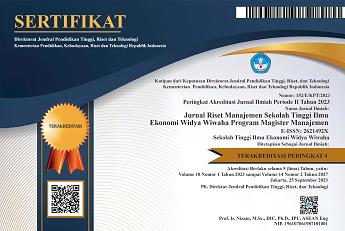ANALISIS FAKTOR-FAKTOR PENYEBAB FRAUD PADA BADAN USAHA MILIK DAERAH (STUDI DI PERUSAHAAN DAERAH BANK PERKREDITAN RAKYAT BANK DAERAH X)
DOI:
https://doi.org/10.32477/jrm.v3i2.68Keywords:
Fraud, Regional Owned Enterprises, Fraud Triangle, Anti-fraud StrategyAbstract
The purpose of this research is to analyze the factors that cause the occurrence of fraud in PD BPR Bank Dearah X which is one of the regional owned enterprises of Local Government X and identify the steps ways of fraud prevention which is effective in PD BPR Bank Daerah X. This research uses a qualitative approach with a case study. This study uses the primary data and secondary data. This research uses many data collection techniques by conducting an interview, an observation and a documentation. The results show that the factors that cause the occurrence of fraud in PD BPR Bank Daerah X can be classified into four, namely: (1) the pressure that comes from the external and internal influence, (2) an opportunity or a chance due to the weakness of internal control systems owned by BPR , sanctions are not strict enough for the wrongdoers of fraud, and misuse of authority committed by directors, (3) rationalization, and (4) collusion. The ways of fraud prevention which are done by the management of PD BPR Bank Daerah X and based on the results of interviews conducted by the researchers, can be identified as follows: (1) An improvement of the internal control system in PD BPR Bank Daerah X, (2) An implementation of policy of know your employee (KYE) as an effort of fraud prevention by controlling the aspects of human resources (HR). (3) A creation of a special line of fraud reporting policy;and (4) An establishment of policies and sanction procedures.
References
Association of Certified Fraud Examiner (2014), Report to the Nations On Occupational Fraud and Abuse-2014 Global Study.
Bank Indonesia (2011), Surat Edaran No. 13/ 28 /DPNP perihal Penerapan Strategi Anti Fraud bagi Bank Umum.
Bank Indonesia (2014), Laporan Hasil Pemeriksaan PD BPR Bank Daerah X Tahun 2013.
Creswell, J. W. (2014), Qualitative Inquiry and Reserach Design: choosing Among Five Approaches, Third Edition, Terjemahan oleh Fawaid, A., Yogyakarta, Pustaka Pelajar.
Denzin, N.K., & Lincoln, Y.S. (2009), Handbook of Qualitative Research, Terjemahan oleh Dariyanto dkk, Yogyakarta, Pustaka Pelajar.
Hennink, M., Hutter, I., & Bailey, A. (2011), Qualitative Research Methods, Sage Publications, Inc., USA.
Kementerian Dalam Negeri (1998), Peraturan Menteri Dalam Negeri Nomor 3 Tahun 1998 tentang Bentuk Hukum Badan Usaha Milik Daerah.
Kementerian Dalam Negeri (2006), Peraturan Menteri Dalam Negeri Nomor 22 Tahun 2006 tentang Pengelolaan Bank Perkreditan Rakyat Milik Pemerintah Daerah.
Lembaga Penjamin Simpanan (2016), Bank yang di Likuidasi, Available at: http:// www.lps.go.id/web/guest/bank-yangdilikuidasi [Accessed February 28, 2016].
Komisi Pemberantasan Korupsi (2006), Memahami untuk Membasmi: Buku Saku untuk Memahami Tindak Pidana Korupsi, Jakarta, Komisi Pemberantasan Korupsi.
Otoritas Jasa Keuangan (2014), Peraturan Otoritas Jasa Keuangan Nomor 20/ POJK.03/2014 tentang Bank Perkreditan Rakyat.
Otoritas Jasa Keuangan (2014), Fraud di Perbankan, Seminar OJK Kantor Regional 3 Jawa Timur, Bali dan Nusa Tenggara, Surabaya, 26 September 2014.
Otoritas Jasa Keuangan (2015), Peraturan Otoritas Jasa Keuangan Nomor 13/POJK.03/2015 tentang Penerapan Manajemen Risiko Bagi Bank Perkreditan Rakyat.
Otoritas Jasa Keuangan (2015), Laporan Hasil Pemeriksaan PD BPR Bank Daerah X Tahun 2014.
Republik Indonesia (2003), Peraturan Pemerintah Nomor 60 Tahun 2008 tentang Sistem Pengendalian Intern Pemerintah.
Republik Indonesia (1998), Undang-Undang Nomor 10 Tahun 1998 tentang Perubahan atas Undang-Undang Nomor 7 Tahun 1992 tentang Perbankan.
Republik Indonesia (2014), Undang-Undang Nomor 23 Tahun 2014 tentang Pemerintahan Daerah.
Singleton, T.W., & Singleton, A.J. (2010), Fraud Auditing and Forensic Accounting, Fourth Edition, John Wiley&Sons, Inc.
Sitorus, T., & Scott, D. (2008), The Roles of Collusion, Organisational Orientation, Justice Avoidance, and Rationalisation on Commission of Fraud: a model based test, Review of Business Research, Vol. 8, No.1.hh 132- 147
Sulistya, A.D. (2013), ‘Strategi AntiFraud Bank Indonesia Untuk Mencegah Kecurangan Yang Dilakukan Pegawai Bank Pada Bisnis Perbankan Di Indonesia’, Tesis, Universitas Gadjah Mada, Yogyakarta.
Tuanakotta, T.M. (2014), Akuntansi Forensik dan Audit Investigatif , Edisi 2., Jakarta, Salemba Empat.
Wells, J.T. (2007), Corporate Fraud Handbook, Prevention and Detection, Second Edition, John Wiley&Sons, Inc.
Yin, R.K. (2014), Case study research: Design and methods, Terjemahan oleh Mudzakir, M.D., Jakarta, RajaGrafindo Persada.









